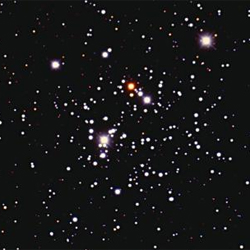 This blog marks my one-year anniversary yakking about any astronomical subject that caught my fancy. Blogs were new at Astronomy in 2006, but blogging seemed like a great vehicle for covering lots of topics in a somewhat random manner. Now, many of our editors blog on a weekly basis.
This blog marks my one-year anniversary yakking about any astronomical subject that caught my fancy. Blogs were new at Astronomy in 2006, but blogging seemed like a great vehicle for covering lots of topics in a somewhat random manner. Now, many of our editors blog on a weekly basis.
I will use this momentous occasion to give you an insight into who I am as an observer. Through the years, many of you have shared with me your favorite objects, observing sites, and more. Here are some of my favorites.
Favorite deep-sky object — Sorry, it would be impossible for me to list just one. Broken down by types, they are:
Open cluster — The Jewel Box Cluster (NGC 4755) in Crux. Before I visited the Southern Hemisphere, my favorite was the Wild Duck Cluster (M11) in Scutum. Now, nothing compares to the Jewel Box. Through a 6-inch scope, star colors all but jump out at you. And their effect becomes more pronounced if you ever-so-slightly defocus the image, rounding out the pinpoint stars.
Globular cluster — M12 in Ophiuchus. This cluster is bright (magnitude 6.1), but it's not one that immediately springs to the minds of observers. And while Omega Centauri, 47 Tucanae, and the Hercules Cluster (M13) shine more brightly, I like M12 because — with enough scope and enough magnification — I can peer right into its heart, resolving stars in its core.
Emission nebula — Thor's Helmet (NGC 2359) in Canis Major. Maybe it's the name. As a child, I read Marvel Comics' Journey into Mystery starring the Mighty Thor. (I still have the first 200 issues.) I also have a long-time interest in Norse mythology. I even named my German shepherd Thor. Yep, must be the name.
Reflection nebula — The Witch Head Nebula (IC 2118) in Eridanus. I've written this elsewhere recently, but seeing this object through a really big scope (20 inches or larger), makes for incredible viewing. Amateurs are so used to describing the Witch Head as "faint, diffuse, barely there," etc. But when it's no problem to see and so big I have to move the scope to view all of it, that's high-end observing.
Dark nebula — Barnard's E (B142 and B143) in Aquila. Named for American astronomer Edward Emerson Barnard, this combination of two of the dark nebulae he cataloged forms an easily visible letter E in the summer Milky Way. Barnard is a favorite of mine because he was an indefatigable observer, one of the best ever. For a terrific biography of Barnard, read William Sheehan's The Immortal Fire Within: The Life and Work of Edward Emerson Barnard (Cambridge, University Press, 1995).
Hmm. I seem to be pretty long-winded after a year of blogs. I'll continue the list next week. A big "thanks" to all of you who have followed my cosmic journey so far. Stay tuned for more space-tastic fun.